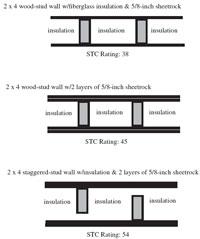Step By Step: How to Soundproof Your Home Theater

| Click image for larger view |
Step 1: Know the Numbers Fortunately, sound acts in predictable ways, traveling through air at 1,130 feet per second and decaying by 6 decibels (dB) every time it doubles in distance. For instance, sound that measures 100 dB at 1 meter from your speaker will be 94 dB at 2 meters away, 88 dB at 4 meters away, and so on. We also know that we perceive a 10 dB difference in level to be about one-half or twice as loud.
Step 2: Determine the STC Rating You can't talk about sound treatment without talking about STC (Sound Transmission Class) ratings, which describe a material's ability to affect sound transfer at frequencies between 125 and 4,000 Hz. The higher the rating, the more noise is blocked. STC ratings depend heavily on the wall's construction, and a material or wall's rating can be increased by adding mass, increasing air space, or adding absorptive material. A wall with an STC rating of 35 to 37 allows medium-loud speech to be heard on the other side. At 50 to 52, loud speech is inaudible, but deep bass can still be heard. A rating greater 65 means most airborne noise is blocked.
Step 3: Select the Right Location Building a quiet room isn't cheap, and selecting the right place for your theater can save you thousands of dollars in treatments. Use a room that can be closed off from the rest of the house. And try to find a location away from areas that produce lots of noise or that require extra quiet: bedrooms, a home office, the nursery, and so on. Seldom-used spaces such as dining rooms, bathrooms, gyms, or hallways are ideal for buffering the theater from the rest of the house. Equipment such as pool pumps and heating/cooling systems produces not only airborne noise, but mechanical noise that's harder to eliminate.























































